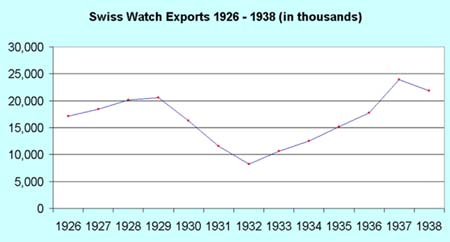
In 1929 18.5% of Swiss watches and clocks were exported to the United
States. In July 1930 the Smoot-Hawley Tariff Bill (this is sometime
written as Hawley-Smoot) was enacted increasing the average tariff on
dutiable articles from 38.5% under the 1922 Fordney-McCumber Tariff to
an average of 53.2%.
The tariff dealing with watches was completely re-written with a combination of specific and ad valorem duties applied according to the classification of the watch or movement as seen in the following table:
Duty on watches imported into the United States under the 1930
Smoot-Hawley
Tariff Bill. (Jones)
|
|
|
|
|
|
|
|
|
|
|
|
|
|
|
|
|
|
|
|
|
|
|
|
|
|
|
|
|
|
|
|
|
|
|
|
|
|
|
|
|
|
|
|
|
|
|
|
|
|
|
|
|
|
|
|
Cheap six jewel watches (Classes 731 and 737) and average quality watches (Classes 751 and 757) represented two-thirds of Swiss watch exports to the United States and it was on these classes that Smoot-Hawley was particularly severe. Total Swiss watch exports declined 24% in 1930 with exports to the United States falling 48%.
In retaliation of the increased duties on watches, embroideries and shoes, Switzerland undertook a boycott of US products. The Swiss Federal Post Office Department adopted the policy of buying no American automobiles and the Swiss Federal Railways and Swiss Banks refused to buy from American firms.
The consolidation of the Swiss watch industry that was already underway was given futher impetus by the fall in world trade. The Swiss government created a super "holding" company ASUAG, the Allgemeine Schweizerische Uhrenindustrie AG (known in French as "Societe Generale de l'Horlogere Swiss SA") which bought up the majority of the shares in Ebauches SA and in several of the leading manufacturers of component parts. In 1934, restrictions on output, and other regulations were given the force of law to reinforce the powers of the company.
It was also in 1934 that the United States began to reduce tariffs
helping to increase trade as the world slowly emerged from the
Depression.

Greg Steer - November 2001